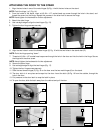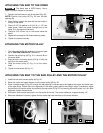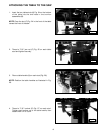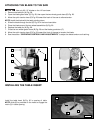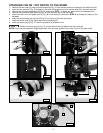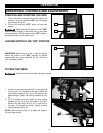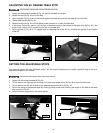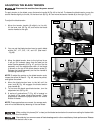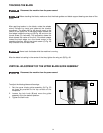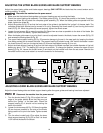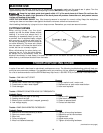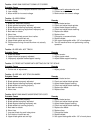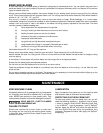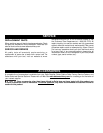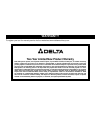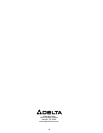
25
BAND SAW BLADES
A band saw blade is a delicate piece of steel that is subjected to tremendous strain. You can obtain long use from a
band saw blade if you use it properly. Be sure to use blades of the proper thickness, width, and temper for the various
types of material and cuts.
Always use the widest blade possible. Use narrow blades only for sawing small, abrupt curves and for fine, delicate
work. This will save blades and will produce better cuts. For cutting wood and similar materials, Delta offers blades in
widths of 1/8", 1/4", 3/8", 1/2", and 3/4".
Any one of a number of conditions may cause a band saw blade to break. Blade breakage is, in some cases,
unavoidable, because of the peculiar stresses to which blades are subjected. Blades will break often due to avoidable
causes, such as the lack of care to the blade or the blade not being properly adjusted to the band saw. The most
common causes of blade breakage are:
(1) faulty alignments and adjustments of the guides.
(2) forcing or twisting a wide blade around a curve of short radius.
(3) feeding the work piece too fast into the blade.
(4) dullness of the teeth, or absence of sufficient set.
(5) improperly tensioned blade.
(6) top guide set too high above the work piece being cut.
(7) using a blade with a lumpy or improperly finished braze or weld.
(8) continuous running of the saw blade when not cutting.
Use blades that are 93-1/2" long on this machine.
Always use a sharp blade. Keep it free from gum and pitch. Clean frequently with a stiff fiber brush.
Narrow blades are used for cutting small circles or curves while the wider blades are best suited for straight cutting
such as ripping.
A new blade, in most cases, will perform better and last longer than a re-sharpened blade.
Ensure that the blade guides are adjusted properly.
Do not force or twist the blade around a curve or a very short radius.
Feed the workpiece through the blade at a consistent rate, allow the blade to do the cutting – do not feed the work
piece too fast.
Do not apply excessive tension to the blade. The tension is only necessary to drive the blade without slipping on the
wheels. Narrow blades require less tension than wider blades.
MAINTENANCE
KEEP MACHINE CLEAN
Periodically blow out all air passages with dry compressed
air. All plastic parts should be cleaned with a soft damp
cloth. NEVER use solvents to clean plastic parts. They
could possibly dissolve or otherwise damage the material.
WEAR ANSI Z87.1 SAFETY GLASSES
WHILE USING COMPRESSED AIR.
FAILURE TO START
Should your machine fail to start, check to make sure
the prongs on the cord plug are making good contact
in the outlet. Also, check for blown fuses or open circuit
breakers in the line.
LUBRICATION
Apply household floor paste wax to the machine table
and extension table or other work surface weekly.
PROTECTING CAST IRON FROM RUST
To clean and protect cast iron tables from rust, you will
need the following materials: 1 pushblock from a jointer,
1 sheet of medium Scotch-Brite™ Blending Hand Pad,
1 can of WD-40
®
, 1 can of degreaser, 1 can of TopCote
®
Aerosol. Apply the WD-40
®
and polish the table surface
with the Scotch-Brite pad using the pushblock as a
holddown. Degrease the table, then apply the TopCote
®
accordingly.



